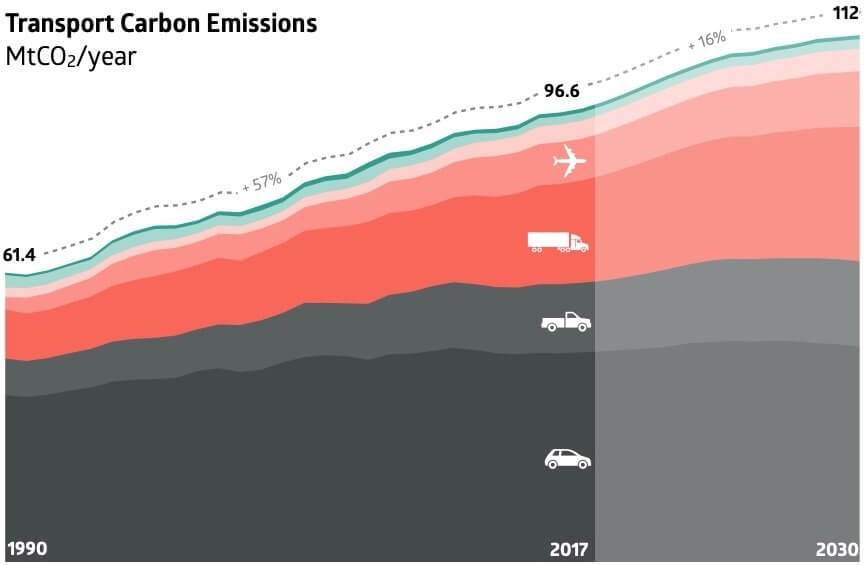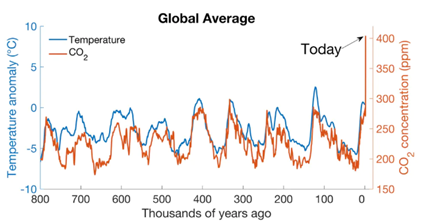West Launceston Primary 3/4c

Hey West Launceston Primary Students!
Thank you for your questions about climate change. You asked some really interesting questions about causes of climate change, impacts and responses.
You'll find answers to your questions from our climate experts below - have a read and watch their answers.
You can also have a look at what other classes across Tasmania asked this year, as well as our climate change toolkit.
Our Questions
Well, the short answer to your question is yes - we do need to change our transport habits. Of the total global CO2 emissions the transportation sector contributes to about 14%. In countries like Australia, with lots more car usage that percentage is even higher. Transport is Australia's third largest source of greenhouse gas emissions (96MtCO2e per year, 17% of total emissions). Cars currently represent the largest source of transport emissions in Australia, and are responsible for roughly half of all transport emissions. Furthermore, car emissions in Australia have grown by 25% since 1990.

But cars are still important for some people to be able to access the community and to get to places. So other options we have are to look at using more fuel efficient cars (some old or big cars use much more fuel) or look at electric vehicles. But, the more walking, cycling, and public transport the better!
Hmm, that’s an interesting (and slightly scary) question. The only reason that Earth may ‘explode’ is if a meteorite the size of the moon impacted the Earth. Large meteorites have impacted Earth before, for example 66 million years ago and that meteorite was probably at least 10-80 km in diameter. That impact caused the outpouring of huge volumes of hot liquid magma in lots of places on Earth’s surface and changed Earth’s climate. The dinosaurs and many reptiles couldn’t cope with those changes and became extinct, which then enabled the mammals to flourish.
Here in Tasmania we also have craters associated with the impact of Meteorites – for example Darwin Crater in southwest Tasmania. That impact was probably around 820,000 years ago.
Interestingly, scientists are now using sediment cores taken from the Darwin crater to find out how the climate changed more than 20,000 years ago.
The climate was always changing, but it is important to understand that there is a big difference between natural climate change (or climate variability) and climate change due to human activities.
Natural climate change
Past natural climate changes have led to the extinction of many species, caused populations to migrate, as well as large changes to land temperatures, the amount of carbon dioxide and other greenhouse gases in the atmosphere, and ocean currents. In the last 800,000 years, for example, the Earth has gone through seven glacial cycles (ice ages), where the Earth was much cooler than today with expansive ice sheets covering much of the globe. At the end of each of these, the climate warmed, in some cases to warmer temperatures than today. The timing of these cycles is mostly controlled by slow changes in Earth’s orbit, which alter the way the Sun’s energy is distributed around the Earth.
Human-caused climate change
Humans have always affected and modified their environment but over the last 200 years, however, human activities have increasingly overridden natural climate processes, and since at least the middle of the 20th century, the warming we are seeing is undeniably a result of human activities. Our actions are causing rising carbon dioxide concentrations to levels higher than at any time in at least the last 800,000 years (see figure below), and rising temperatures in the atmosphere, ocean and on land are at a scale and rate never seen before. This is leading to the increasing frequency and intensity of extreme events such as bushfires, cyclones, heatwaves, floods and droughts we are experiencing.

Australia has seen plenty of climate related disasters in recent years. Most recently during the past year, floods in Qld, NSW, Vic, SA and Tasmania have been very damaging and costly to communities across the country.
Before the floods, we saw widespread bushfires during the summers of 2019/20 (mainland Australia) and 2018/19 (Tasmania), which motivated a Government investigation into how Australia can improve its National Natural Disaster Arrangements. The outcomes of that report states ‘Australia’s disaster outlook is alarming, with climate change exacerbating bushfires, extreme rainfall and flooding’.
‘Responding to climate disasters’ requires action in many ways.
- We should seek to prevent disasters. This would include activities like removing or reducing the population that live in areas that are exposed to climate hazards like floods or bushfires.
- We should be well prepared for disasters. This would include activities like having accurate early warning systems, that initiate action to minimise impacts in the immediate lead-in of a hazard event.
- We would be well positioned to respond during an event. During the time of crisis, we should have the resources to assist people in need and minimise harm.
- We should be able to support communities to recover after an event. After a disaster has struck, it takes a lot of time and effort for a community to recover to what it was beforehand. Ideally, we should aim to recover to be better prepared for future events (build back better).
Currently, almost all of the money spent on disasters is during the event (responding) or after (recovering). We should aim to be better prepared in the first instance, to minimise any damage happening at all.
Responding to the climate crisis needs us to both
- reduce our emissions as fast as possible (e.g., the emphasis on emissions reduction and targets for net-zero), AND
- invest early in climate change adaptation and/or disaster mitigation (e.g., steps to minimise the adverse impacts of foreseeable hazards, by reducing the exposure and/or vulnerability to those hazards), to manage the climate change impacts already committed.
Further reading:
It can be very frustrating to witness the slow pace of action by governments to limit climate change, particularly when we look at the record of the current Australian Federal Government. But Australia did once have a very effective climate policy. Julia Gillard's government introduced the Clean Energy Act, which put a price on carbon emissions, and operated from 2012-2013. This reduced carbon emissions by the biggest polluting companies by 7%. But the price on carbon only lasted one year because Australians voted to replace the Labor Gillard government with a Coalition government under Tony Abbott, who repealed the Act.
Since then, Australia has not had an effective national climate policy. But several state governments, local governments and and some companies have introduced their own policies. The Tasmanian Government is now legislating that Tasmania will have a Net Zero carbon emissions by 2030.
Momentum is building and we still have a small window of opportunity for our governments to make systemic change to limit global climate change to 1.5 or 2 degrees Celcius.
What are the things that make governments act on climate change?
- Voters. If enough people of voting age tell political parties that they won't vote for them unless they promise to act on climate change, they would be forced to act, or lose power. You may not be of voting age, but you can tell the adults in your life who do vote how important this issue is to you.
- International pressure. Australia is part of the United Nations. This organisation of 193 countries has an international convention on climate change, which Australia is a signatory to, and must abide by. The COP 26 Climate Summit in Glasgow is the latest meeting at which countries will agree on actions over the coming decade.
- Economics. Fossil fuels are becoming risky investments, while renewable energy is a growing industry that will create more jobs and profit. Governments eventually have to face this reality, and make sure their policies enable Australians to profit from new industries, rather than propping up doomed ones.
Climate change is caused by natural processes but also increasingly by human activities. The main driver of climate change is the greenhouse effect. Some gases in the atmosphere have a similar function to the glass in a greenhouse. The glass walls of a greenhouse let heat and light from the Sun in, which warms up the air inside. Similarly, greenhouse gases let the incoming heat from the Sun pass through to the Earth’s surface, where it is trapped. Many of these gases occur naturally, and natural causes of changes to the greenhouse effect include solar radiation and volcanic activity. But human activities are increasing the concentrations of some greenhouse gases in the atmosphere, in particular carbon dioxide, methane, nitrous oxide and fluorinated gases, leading to an enhanced greenhouse effect and warmer temperatures.
The main human activities causing these changes are:
- Burning of fossil fuels such as coal, oil and gas, which produce carbon dioxide and nitrous oxide
- Deforestation, which means that there are less trees to help absorb carbon dioxide from the atmosphere, and carbon stored in the trees is released to the atmosphere
- Increasing livestock farming, which is problematic as cows and sheep, for example, produce large amounts of methane when they digest their food
- Fertilisers containing nitrogen, which produce nitrous oxide emissions
- Fluorinated gases, which are emitted from equipment and products that use these gases, such as refrigerators, air conditioners and heat pumps
While natural processes play a role in how the climate changes, what we are currently experiencing cannot be explained by natural processes alone. Since at least the mid 20th century, humans are unequivocally causing climate change, and unless we modify how we live and how we interact with the environment around us, this will continue to be the case.













